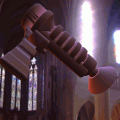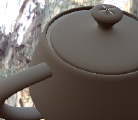| Spherical harmonic Shading
|
|
|
|
|
|
|
|
| Tech Report, Computer Science department - Cliff Lindsay & Emmanuel Agu - Spring '04 WPI
|
|
|
Previously, graphics hardware and lighting algorithms for real-time rendering have focused on distant point light sources, which resulted in illumination that was less than optimal. To improve the quality of real-time graphics, more sophisticated offline rendering techniques, such as Global Illumination, need to be incorporated into real-time renders. Unfortunately, Global Illumination style lighting is impractical for real-time rendering because of the computational complexity involved in integrating over a hemisphere. Fortunately, several advances have been made in real-time graphics such as Spherical Harmonic shading that approximate hemispherical lighting and make Global Illumination possible in real-time.
There currently exists a plethora of lighting techniques that can generate images that look photorealistic to varying degrees. Some of these techniques include ray tracing, Radiosity, and multi-pass rendering. The disadvantage associated with these techniques is the lack of real-time rendering capability on modest graphics hardware (nonclustered rendering engines). Spherical Harmonics appears to be a panacea for the real-time Global Illumination problem by tractably reducing the light integration problem to a simple linear operation. Real-time Global Illumination like lighting can be achieved through several linear properties of Spherical Harmonics. These properties reduce integration over the hemisphere into a dot product for diffuse receivers and a linear transform for glossy receivers, caustics, interreflections, and soft and self-shadowing.
This paper will serve as a broad overview of the properties and compositions of Spherical Harmonics as well as provide the background on the notation. This paper will also discuss the numerous benefits of using Spherical Harmonics for approximating lighting and transfer of 3D models for real-time applications. In addition, this review will serve as a framework for learning more about the functional properties of Spherical Harmonic shading.
|
|
|
SH References:
|
[1] J. Kautz, P. Sloan, J. Snyder. Fast Arbitrary BRDF Shading for Low-Frequency Lighting Using Spherical Harmonics. Proceedings of the 13th Eurographics workshop on Rendering, pages 291-296, 2002.
[2] P. Sloan, J. Kautz, J. Snyder, Precomputed radiance transfer for real-time rendering in dynamic, low-frequency lighting environments. ACM Transactions on Graphics (TOG), pages 527-536, 2002.
[3] R. Ramamoorthi, P. Hanrahan, An Efficient Representation for Irradiance Environment Maps. Proceedings of ACM SIGGRAPH 2001, Computer Graphics Proceedings, Annual Conference Series, pages 497-500, 2001.
[4] R. Ramamoorthi, P. Hanrahan, Frequency Space Environment Map Rendering. Proceedings of ACM SIGGRAPH 2002, pages 517-526, 2002.
|


